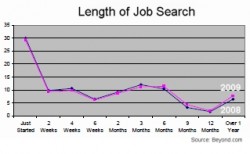Two labor-related reports this week offer no evidence that the recession Wall Street believes is over really is, at least so far as workers are concerned.
![]() The Conference Board’s monthly Help-Wanted OnLine Data Series reported that online job postings dropped by 83,000 in October. The number of newly posted jobs dropped by 24,000.
The Conference Board’s monthly Help-Wanted OnLine Data Series reported that online job postings dropped by 83,000 in October. The number of newly posted jobs dropped by 24,000.
“The September and October numbers are a further indication that, thus far, the recovery is weak,” says Gad Levanon, senior economist at The Conference Board. “Labor demand is a leading indicator of employment, and the numbers indicate that employment is not likely to rise for the rest of this year.”
That’s bad news for the nation’s 15 million unemployed workers, whose numbers are only expected to swell when the official government report for October is released Friday. One survey of labor economists predicts the U.S. Bureau of Labor Statistics will report that 175,000 jobs disappeared during the month. Another survey predicts the number will be closer to 150,000. Either way, the unemployment rate, 9.8 percent in September, is also expected to rise.
Only a few days old and the beginning of the seasonal hiring slowdown anyway, November is starting off with news of a layoff of 8,000 workers by Johnson & Johnson. The pharmaceutical company said its layoff of between 6 and 7 percent of its global workforce will save it $800-$900 million.
Despite some positive manufacturing and economic news in the last several days, workers are still struggling to find work.
A report from job board operator Beyond.com says 47 percent of the job seekers to its 15,000+ websites reported being recently laid off. Another 22 percent said they are looking because they are unsatisfied or insecure in their current job.
 Of the job seekers responding to the quarterly survey on the Beyond.com network, 7.7 percent said they have been looking for a year or more. That’s a 20 percent increase from the previous quarter (April-June 2009) when 6.43 percent reported their job search was taking longer than a year.
Of the job seekers responding to the quarterly survey on the Beyond.com network, 7.7 percent said they have been looking for a year or more. That’s a 20 percent increase from the previous quarter (April-June 2009) when 6.43 percent reported their job search was taking longer than a year.
The Beyond.com report doesn’t provide numbers or a more detailed breakdown, so it’s not possible to say how many of those are unemployed. However, the BLS September report said that among the unemployed, 35.6 percent were out of work more than 27 weeks, about the time when unemployment benefits begin to run out.
On the Beyond.com network, two-thirds of the job seekers posting resumes had five or more years of experience. The biggest percentage jump in candidates from the second to the third quarters has been among those with 21 years or more experience, suggesting older workers are having a tougher time getting reemployed. No surprise, at least on the Beyond network, where 76 percent of the job postings were for positions requiring less than a year experience. That’s up from the 55 percent recorded in the previous quarter.
Tomorrow, Monster releases its monthly employment index. It’s been stagnant since the beginning of the year, rising a little, then falling back. In September the index was at 119. In September of 2008 it was at 160.
To add to the doldrums, the Consumer Confidence Index released last week by The Conference Board for October was 47.7, down from September’s revised 53.4.